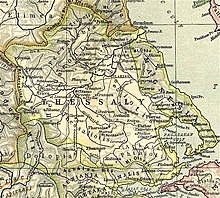Pherai
Pherai ( ancient Greek Φεραί even Phera, Pherae ) was an ancient city in Thessaly landscape Pelasgiotis , near the sea, in the mythology known as the seat of Admetus , whose son Eumelos the community leader of Pheräer and Iolker before Troy was.
The city of Pherai controlled the only major port in Thessaly, Pagasai, and profited from the export of grain and trade in other goods. With growing prosperity, a middle class formed in the city that also made political claims. Towards the end of the Peloponnesian War , Pherai became the seat of an independent tyrant rule that had an influence on Greece for a long time. These sole rulers operated in the 4th century BC. A highly expansive policy and strived for hegemony over all of Thessaly. Based on the broad mass of traders and craftsmen - that non-aristocratic class whose political weight was insignificant for so long - and on the "Nautikos ochlos" based in the Pherai-dependent port city of Pagasai, it was the first Lycophron of Pherai , a thoroughly popular one To establish tyranny .
The social structure of the port city of Pagasai differed from the other cities of Thessaly in that it was not dominated by the agrarian, but the mercantilist element and the seafarers. In addition, there was no long-established aristocratic family in either Pherai or Pagasai, which made it easier for the new class to rise.
Among the tyrants of Pherai are Lykophron (reign: around 406–390 BC), the 404 BC. Won a battle against an aristocratic army under the leadership of the Aleuads , Jason (around 375 BC), commander-in-chief of all of Thessaly, his son Lycophron and Alexander (murdered in 358).
Antiochus III. of Syria besieged and conquered Pherai in 191, but had to hand it over to the Romans soon afterwards. The city had an acropolis and within its circular walls the much-mentioned source Hypereia , which still gushes out north of the city of Velestino , where sparse remains of the old Pherai have been preserved. The municipality of Velestino was renamed Feres after the ancient city .
literature
- Herwig Kramolisch: Pherai. In: The New Pauly (DNP). Volume 9, Metzler, Stuttgart 2000, ISBN 3-476-01479-7 , column 767.
Remarks
- ↑ See Slawomir Sprawski. Were Lycophron and Jason tyrants of Pherae? . In: Christopher Tulin / Vincent Azoulay (eds.): Xenophon and his world (= Historia Einzelschriften 172). Franz Steiner Verlag, Stuttgart 2004, p. 441.
- ↑ See Hans Beck: Polis and Koinon (= Historia Einzelschriften 114). Franz Steiner Verlag, Stuttgart 1997, p. 127.
Coordinates: 39 ° 23 ′ 1 ″ N , 22 ° 44 ′ 47 ″ E
